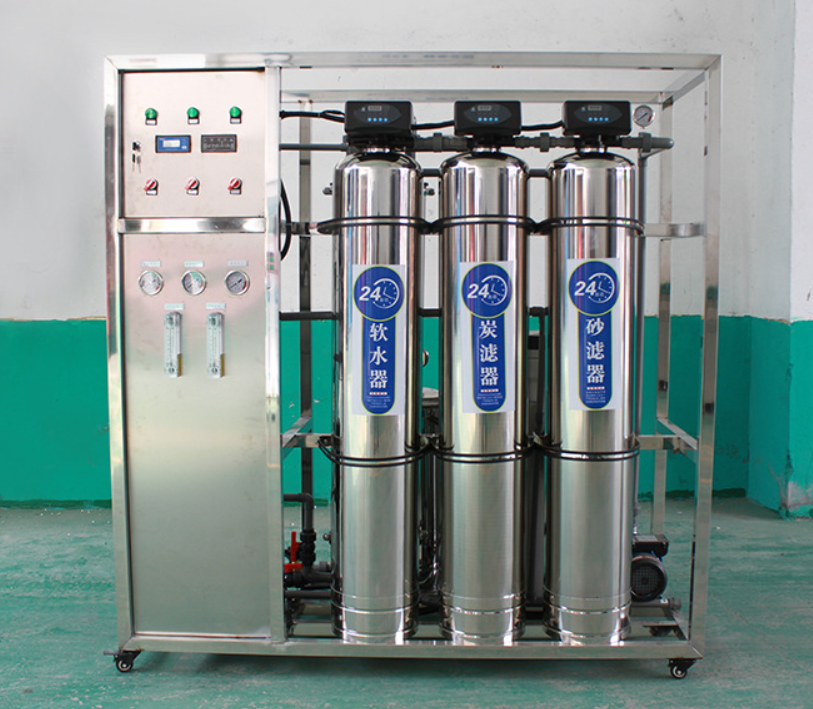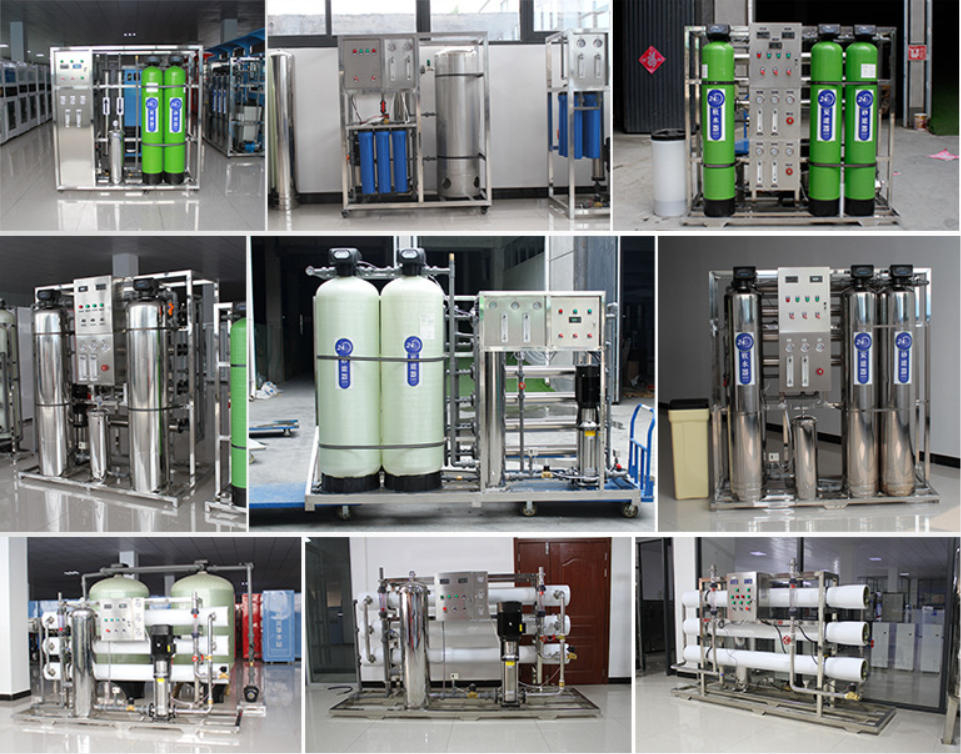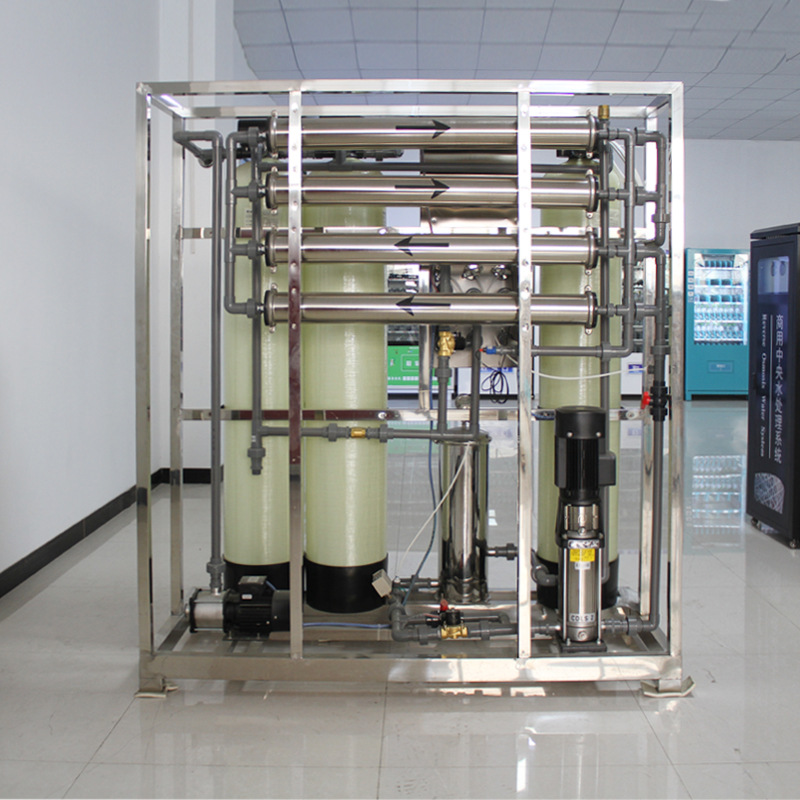What is reverse osmosis water purification equipment?
Oct 18, 2023
What is reverse osmosis water purification equipment?
Reverse osmosis water purification equipment is a type of equipment that uses semi-permeable membrane technology to achieve efficient water purification. It applies a certain pressure to the source water, causing the water molecules in the source water to pass through the semipermeable membrane and become pure water, while other substances in the source water (such as inorganic salts, heavy metals, organic matter, bacteria, viruses, etc.) are absorbed by the semipermeable membrane. Interception becomes concentrated water, thereby achieving the separation of water and solute.
The core component of reverse osmosis water purification equipment is the reverse osmosis membrane. It is a membrane with special structure and function. Its pore size is very small, only at the nanometer level (1 nanometer = 10-9 meters), which is equivalent to 1 of the size of E. coli. /6000, 1/300 of the virus size. Therefore, the reverse osmosis membrane can effectively remove most impurities and harmful substances in the water and achieve a high standard of purification effect.

How does reverse osmosis water purification equipment work?
The working process of reverse osmosis water purification equipment can be divided into the following steps:
Pretreatment: The source water passes through pretreatment equipment such as precision filters and activated carbon filters to remove suspended matter, colloids, sediment, organic matter, residual chlorine and other impurities in the water, reduce the turbidity and color of the water, and ensure the performance of the reverse osmosis membrane. Incoming water quality.
High-pressure pump: The pretreated water is pressurized by a high-pressure pump to increase the pressure of the water to reach the working pressure of the reverse osmosis membrane (generally 1.5-2.5 MPa).
Reverse osmosis membrane: The pressurized water is evenly distributed to each reverse osmosis membrane element. After the separation of the reverse osmosis membrane, two water flows are formed: one part passes through the reverse osmosis membrane and becomes pure water (also called permeate water). or produced water), and the other part fails to pass through the reverse osmosis membrane and becomes concentrated water (also called concentrated water or wastewater). Pure water flows out from each reverse osmosis membrane element. After collection, it is monitored by instruments such as flow meters and pressure gauges, and then flows out of the equipment outlet into the pure water tank. Concentrated water flows out from each reverse osmosis membrane element, and after collection, it passes through flow meters and pressure gauges. After monitoring by pressure gauges and other instruments, it flows out of the equipment outlet for discharge or recycling.
Post-treatment: Depending on different uses and requirements, purified water can also be further processed through post-treatment equipment, such as UV sterilizers, ozone generators, ultrafilters, mixed beds, etc., to improve the quality and stability of purified water.

What are the advantages of reverse osmosis water purification equipment?
Reverse osmosis water purification equipment has the following advantages:
Good purification effect: the reverse osmosis membrane can remove more than 98% of inorganic salts, heavy metals, organic matter and 100% of microorganisms in source water (theoretically), and the pure water produced meets the national drinking water standards or higher.
Energy saving and environmental protection: Reverse osmosis water purification equipment does not need to add any chemicals, produces pure water without phase change, and has low energy consumption; concentrated water can be recycled or discharged, and no acid-base waste liquid is discharged.
Compact structure: The reverse osmosis water purification equipment adopts a modular design, which covers a small area, is easy to install, simple to operate, and has low maintenance costs.

Reverse osmosis water purification equipment is a type of equipment that uses semi-permeable membrane technology to achieve efficient water purification. It applies a certain pressure to the source water, causing the water molecules in the source water to pass through the semipermeable membrane and become pure water, while other substances in the source water (such as inorganic salts, heavy metals, organic matter, bacteria, viruses, etc.) are absorbed by the semipermeable membrane. Interception becomes concentrated water, thereby achieving the separation of water and solute.
The core component of reverse osmosis water purification equipment is the reverse osmosis membrane. It is a membrane with special structure and function. Its pore size is very small, only at the nanometer level (1 nanometer = 10-9 meters), which is equivalent to 1 of the size of E. coli. /6000, 1/300 of the virus size. Therefore, the reverse osmosis membrane can effectively remove most impurities and harmful substances in the water and achieve a high standard of purification effect.

How does reverse osmosis water purification equipment work?
The working process of reverse osmosis water purification equipment can be divided into the following steps:
Pretreatment: The source water passes through pretreatment equipment such as precision filters and activated carbon filters to remove suspended matter, colloids, sediment, organic matter, residual chlorine and other impurities in the water, reduce the turbidity and color of the water, and ensure the performance of the reverse osmosis membrane. Incoming water quality.
High-pressure pump: The pretreated water is pressurized by a high-pressure pump to increase the pressure of the water to reach the working pressure of the reverse osmosis membrane (generally 1.5-2.5 MPa).
Reverse osmosis membrane: The pressurized water is evenly distributed to each reverse osmosis membrane element. After the separation of the reverse osmosis membrane, two water flows are formed: one part passes through the reverse osmosis membrane and becomes pure water (also called permeate water). or produced water), and the other part fails to pass through the reverse osmosis membrane and becomes concentrated water (also called concentrated water or wastewater). Pure water flows out from each reverse osmosis membrane element. After collection, it is monitored by instruments such as flow meters and pressure gauges, and then flows out of the equipment outlet into the pure water tank. Concentrated water flows out from each reverse osmosis membrane element, and after collection, it passes through flow meters and pressure gauges. After monitoring by pressure gauges and other instruments, it flows out of the equipment outlet for discharge or recycling.
Post-treatment: Depending on different uses and requirements, purified water can also be further processed through post-treatment equipment, such as UV sterilizers, ozone generators, ultrafilters, mixed beds, etc., to improve the quality and stability of purified water.

What are the advantages of reverse osmosis water purification equipment?
Reverse osmosis water purification equipment has the following advantages:
Good purification effect: the reverse osmosis membrane can remove more than 98% of inorganic salts, heavy metals, organic matter and 100% of microorganisms in source water (theoretically), and the pure water produced meets the national drinking water standards or higher.
Energy saving and environmental protection: Reverse osmosis water purification equipment does not need to add any chemicals, produces pure water without phase change, and has low energy consumption; concentrated water can be recycled or discharged, and no acid-base waste liquid is discharged.
Compact structure: The reverse osmosis water purification equipment adopts a modular design, which covers a small area, is easy to install, simple to operate, and has low maintenance costs.

related
- The Features of Sintered Mesh Filter Compared with Traditional Filter
- How to Choose a Suitable Hydraulic Oil Filter
- Types of Hydraulic Oil Filter Element
- Filtration Material of Hydraulic Oil Filter
- The function of the inner and outer skeletons of the hydraulic oil filter element
- Which is better, Spiral Skeleton or Punch Plate Skeleton
- The difference between Carbon Steel and Stainless Steel
- The Difference Between Sintered Filter and Ordinary Filter

